Priscilla Bracks, a Brisbane-based artist i met in London a few months ago, has written for wmmna a review of a show she saw recently over in Australia. Priscilla is working in photography, digital media, illustration and installation. Her work explores how the here and now, chaos and change influence our personal and cultural identities, and the futures we bring to life through our imaginations.
Priscilla is also a qualified solicitor. Inspired by a desire to assist in the development of sustainable careers for artists, she has worked in a number of roles developing government arts policy.
Her report from the show:
Experimenta Vanishing Point is a touring exhibition of Australian and International new media arts, currently at the Ipswich Art Gallery in Queensland, Australia. Experimenta have been commissioning artworks and touring artworks for 21 years, and have become renown for their ability to put together an inspiring show. Experimenta Vanishing Point is no exception.
 Duk-eum
Duk-eum
The show features interactive works, video and animation such as Ji-Hoon Byun’s Duk-Eum 2003. Duk-Eum is an interactive video installation that envelops its audience in a virtual waterfall of light particles. The installation uses video tracking to monitor movement and human presence across a screen where the waterfall is being projected. The person’s shadow seems to cause the water to splash and shimmer around the body. The work was inspired by Korean traditional singers, who in the pursuit of ‘duk-eum’, the highest grade of training, stand under noisy waterfalls to practice singing. Whilst the programming that drives this work may be complex, the outcome is sublime in its simplicity. Duk-Eum is a mesmerising experience, as compelling as the desire to stare into a fire, but it is also totally engaging as it seduces the visitor into feeling they have the almost god-like power to effect the flow of the waterfall.
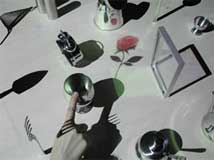
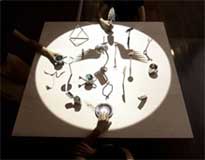 Minim++, Tool’s Life 2001
Minim++, Tool’s Life 2001
Another playful interactive work in the show is Tool’s Life 2001, by Minim++ (Japanese artists Kyoko Kunoh and Motoshi Chikamori). This work offers a glimpse into the secret lives of inanimate objects, and reveals personalities hidden within each. A range of banal, passive objects are arranged on a table and bathed in a pool of light from a data projector. Each object is metallic and responds to touch with a shadow animation and sounds that seem to come from the object itself. It seems to work by detecting earthing of electrical current, because it responded better when I took off my shoes.
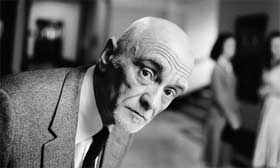 The Shy Picture 2005, by David MacLeod and Narinda Reeders is an interactive work that blends photography and performance. The key frame in this video based work, is a black and white image, reminiscent of a traditional film still. Displayed on an LCD screen that is framed like an ordinary photograph, the work seems quite unassuming until you attempt to look at it. Movement in front of the picture ‘frightens’ the subjects in the photograph who run away to hide. When they are sure they are no longer being watched, they sneak back into the frame, and assume their still positions. Beautiful film noir lighting, careful casting of characters and tight direction combine to make this a very special work.
The Shy Picture 2005, by David MacLeod and Narinda Reeders is an interactive work that blends photography and performance. The key frame in this video based work, is a black and white image, reminiscent of a traditional film still. Displayed on an LCD screen that is framed like an ordinary photograph, the work seems quite unassuming until you attempt to look at it. Movement in front of the picture ‘frightens’ the subjects in the photograph who run away to hide. When they are sure they are no longer being watched, they sneak back into the frame, and assume their still positions. Beautiful film noir lighting, careful casting of characters and tight direction combine to make this a very special work.
Experimenta Vanishing Point also features some very clever video works. June Bum Park’s I Parking & III Crossing, 2002 uses perspective and an exceptional depth of field to create the impression that the artist’s hands guides the movement of toy-like cars and ant-sized people in a miniature world. Made without the aid of digital manipulation, the work looks down on street scenes, filmed from what seems to be a great height. Park’s hands in seem to hold back traffic to allow people to cross the street, and assist cars into tight parks. After some analysis it becomes clear that Park’s hands are in the foreground of these images shot with extreme foreshortened perspective, but this is in no way immediately apparent in these videos, which when played back at high speed effectively suspend any disbelief.
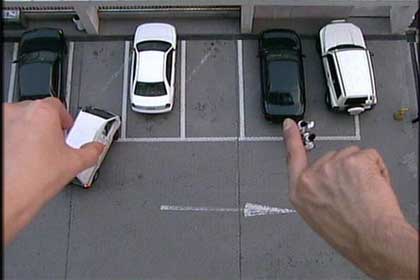 Parking I
Parking I
Australian artist Daniel Crooks’ video work Train No. 8, is another clever video work in the show which distorts a normally constrained parameter in our lives: time. In Train No. 8 images from a train journey around suburban London are spliced and interlaced so that some splices of the image move forwards in time, whilst others move backwards.
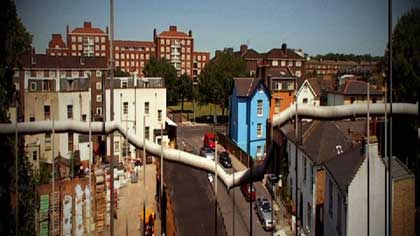
Train No.8
Image of Train No.8 courtesy of the artist and Sherman Galleries, Sydney.
An Experimenta New Visions Commission
